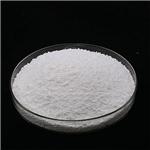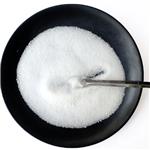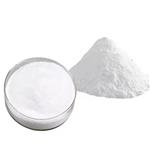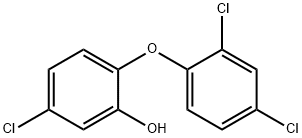Triclosan
- CAS No.
- 3380-34-5
- Chemical Name:
- Triclosan
- Synonyms
- IRGASAN;ch3565;TROX-100;riclosan;TRICLOSAN;Yriclosan;TRICHLOSAN;Cloxifenol;ZilesanUW.;Ttriclosan
- CBNumber:
- CB6771432
- Molecular Formula:
- C12H7Cl3O2
- Molecular Weight:
- 289.54
- MDL Number:
- MFCD00800992
- MOL File:
- 3380-34-5.mol
- MSDS File:
- SDS
| Melting point | 56-60 °C(lit.) |
|---|---|
| Boiling point | 290°C(lit.) |
| Density | 1.4214 (rough estimate) |
| vapor pressure | 0.001Pa at 25℃ |
| refractive index | 1.4521 (estimate) |
| storage temp. | 2-8°C |
| solubility | H2O: soluble12g/L at 20°C |
| pka | 7.9(at 25℃) |
| form | Solid |
| color | colorless or white |
| Water Solubility | Soluble in ethanol, methanol, diethyl ether and sodium hydroxide solution (1M). Slightly soluble in water. |
| Merck | 14,9657 |
| BRN | 2057142 |
| Stability | Stable. Incompatible with strong oxidizing agents. |
| InChIKey | XEFQLINVKFYRCS-UHFFFAOYSA-N |
| LogP | 4.9 at 20℃ |
| CAS DataBase Reference | 3380-34-5(CAS DataBase Reference) |
| FDA 21 CFR | 310.545 |
| EWG's Food Scores | 4-7 |
| FDA UNII | 4NM5039Y5X |
| ATC code | D08AE04,D09AA06 |
| NIST Chemistry Reference | Triclosan(3380-34-5) |
| EPA Substance Registry System | Triclosan (3380-34-5) |
| Cosmetics Info | Triclosan |
SAFETY
Risk and Safety Statements
| Symbol(GHS) |   GHS07,GHS09 |
|||||||||
|---|---|---|---|---|---|---|---|---|---|---|
| Signal word | Warning | |||||||||
| Hazard statements | H315-H319-H410 | |||||||||
| Precautionary statements | P264-P273-P280-P302+P352-P305+P351+P338-P332+P313 | |||||||||
| Hazard Codes | Xi,N | |||||||||
| Risk Statements | 36/38-50/53-36/37/38 | |||||||||
| Safety Statements | 26-39-46-60-61-24/25-22-36 | |||||||||
| RIDADR | UN 3077 9/PG 3 | |||||||||
| WGK Germany | 2 | |||||||||
| RTECS | KO1100000 | |||||||||
| TSCA | Yes | |||||||||
| HazardClass | 9 | |||||||||
| PackingGroup | III | |||||||||
| HS Code | 29095000 | |||||||||
| Toxicity | LD50 orl-rat: 3700 mg/kg 26UZAB 6,245,68/70 | |||||||||
| NFPA 704 |
|
Triclosan price More Price(49)
| Manufacturer | Product number | Product description | CAS number | Packaging | Price | Updated | Buy |
|---|---|---|---|---|---|---|---|
| Sigma-Aldrich | 72779 | Irgasan 97.0-103.0% (active substance, GC) | 3380-34-5 | 5G | $47.5 | 2024-03-01 | Buy |
| Sigma-Aldrich | 72779 | Irgasan 97.0-103.0% (active substance, GC) | 3380-34-5 | 25g | $147 | 2024-03-01 | Buy |
| Sigma-Aldrich | 1682206 | Triclosan United States Pharmacopeia (USP) Reference Standard | 3380-34-5 | 200mg | $436 | 2024-03-01 | Buy |
| Sigma-Aldrich | 647950-M | Triclosan - CAS 3380-34-5 - Calbiochem A potent antimicrobial agent that inhibits bacterial fatty acid synthesis by selectively targeting Fabl encoded enoyl-acyl carrier protein (ACP) reductase. | 3380-34-5 | 1g | $88.4 | 2022-05-15 | Buy |
| Sigma-Aldrich | 647950-M | Triclosan - CAS 3380-34-5 - Calbiochem A potent antimicrobial agent that inhibits bacterial fatty acid synthesis by selectively targeting Fabl encoded enoyl-acyl carrier protein (ACP) reductase. | 3380-34-5 | 647950-1GM | $94.2 | 2022-05-15 | Buy |
Triclosan Chemical Properties,Uses,Production
Disinfectants
Triclosan is an efficient broad-spectrum topical antimicrobial disinfectant which is normally white or off-white crystalline powder. It has a slightly phenolic odor. It is insoluble in water but easily soluble in organic solvents and alkali. It has a relative stable chemical property and is heating-resistant and also resistant to acid and alkali hydrolysis without generating any symptoms of the toxicity and environmental pollution. It is internationally recognized as a fungicide variety with specific efficacy. It can kill bacteria such as Staphylococcus aureus, Escherichia coli and fungi such as Candida albicans. It also has an inhibitory effect on the virus (e.g., hepatitis B virus, etc.) while being able to protect the beneficial bacteria. The mechanism of action of triclosan is as below: it is first adsorbed on the bacterial cell wall and then further penetrates through the cell wall and has reaction with the lipid and protein in the cytoplasm, and thus resulting in protein denaturation which further kill the bacteria. Currently it has been widely applied to highly-efficient medicated soap (health soap, health lotion), removing underarm odor (foot aerosol), hand sanitizer, wound disinfectant sprays, medical equipment disinfectants, hygiene cleanser (cream), and air fresheners and refrigerator deodorants and some other daily chemicals. It is also used for the cleaning of the health fabric and the anti-corrosion treatment of plastics. Its high purity version can be added to the toothpaste and mouthwash for treatment of gingivitis, periodontitis and oral ulcers. The State content must not exceed 0.3%.
Carcinogenicity
In 2004, a teacher (Dr. Peter Vikesland) from the Virginia Tech University (US) had found from the experiments that the reaction between the triclosan-containing product and the chlorine-containing tap water containing can generate a substance known as "chloroform aryl", that is, chloroform (chemical name: trichloromethane) which is a colorless, volatile liquid with a special sweetness. Upon exposure to light, it will be oxidized to generate hydrogen chloride and phosgene. It had been once used as an anesthetic. Animal experiments have found that this substance will do harm to the heart and liver with mild teratogenicity and can induce the liver cancer of mice. However, so far no studies on the human carcinogenicity have been reported. For insurance purposes, both the International Cancer Research Centre and the United States have already has the chloroform be listed as suspected carcinogens to the human body.
Carcinogenic controversy
At present, there is still controversy about whether triclosan is carcinogenic to humans, and there is not enough evidence to confirm its carcinogenicity to humans. It was reported earlier that long-term exposure to triclosan would induce liver cirrhosis in mice, and the 2014 PNAS article reported it again Triclosan has the effect of promoting liver tumor, and the journal Science in 2016 also proposed the hepatotoxic effect of triclosan. Chinese mandatory national standard (GB22115-2008) promulgated in 2008 for raw materials for toothpaste stipulates that triclosan is allowed to be added to toothpaste, but the content should not exceed 0.3%.
Toothpaste Standard
The national standard of the toothpaste used in China is the new national standard of toothpaste (GB8372-2008) implemented on February 1, 2009. Compared with the 2001 version of toothpaste standard, the new national standard has been supplemented and adjusted in various aspects. In the new national standard of toothpaste, the prohibited or restricted ingredients include nearly 1,500 kinds, including diethylene glycol and triclosan. The provision of diethylene glycol is that it is not allowed to artificially add it to the raw materials, such as being introduced as impurities. Its content in the toothpaste should not exceed 0.1%. Triclosan were listed as being allowable preservatives but with the usage amount not exceeding 0.3%. The new national standard has ruled that the fluorine content of the fluoride-containing toothpaste should be within the range of 0.04%-0.15%, and the fluoride content should be within the range of 0.05% to 011% for children fluoride-containing toothpaste.
The above information is edited by the chemicalbook of Dai Xiongfeng.
Chemical Properties
It is colorless and long needle-like crystals with a melting point being around 54-57.3 ℃ (60-61 ℃). It is slightly soluble in water and soluble in ethanol, acetone, ethyl ether and alkali solution. It has a chloro-phenol odor.
Uses
1. It can be used as antiseptic and fungicide and applied to cosmetics, emulsions and resins; also can be used for the manufacture of disinfection medicated soap. The LD50 of mice subject to oral administration of this product is 4g/kg.
2. It can be used for the production of top-grade daily chemical product, the disinfectants of medical instrument as well as diet instrument as well as the preparation of the anti-bacterial, deodorant finishing agent of fabric.
3. It can also be applied to biochemical studies. It is a kind of broad-spectrum antimicrobial agents which inhibit the type II fatty acid synthase (FAS-II) of bacteria and parasites, and also inhibits the mammalian fatty acid synthase (FASN), and may also have anticancer activity
Production method
1. Take 2, 4-dichloro-phenol as the raw material; use 2,4-dichloro-phenol to react with potassium hydroxide to generate dichlorophenol potassium which further reacts with 2,5-dichloro-nitrobenzene in the catalysis of copper for generation of 2,4,4-trichloro-2'-nitro diphenyl ether. It is further reduced by iron powder to generate 2, 4, 4-trichloro-2'-amino diphenyl ether, and then further went through diazotization hydrolysis to obtain the product.
2. Take o-methoxyphenol as the raw material: have potassium hydroxide powder reacted with guaiacol to generate guaiacol potassium. Apply reaction between bromobenzene and methoxy ether, together with chlorine for chlorination to obtain 2, 4, 4’-trichloro-2'-methoxydiphenyl ether. Take AICI3 as hydrolysis catalyst to generate 2,4,4'-trichloro-2'-hydroxydiphenyl ether.
Description
Triclosan is a broad-spectrum antibacterial agent that inhibits bacterial fatty acid synthesis. It is effective against Gram-negative and Gram-positive bacteria, as well as against Mycobacteria. Triclosan is used in a variety of products, including antiseptic soaps, deodorants, and hand washes.
Chemical Properties
Solid
Physical properties
Triclosan is a slightly aromatic high-purity white crystalline powder; Solubility: slightly soluble in water, moderately soluble in dilute alkali, has high solubility in many organic solvents, in water-soluble solvents or surfactants After dissolving, it can be made into a transparent concentrated liquid product.
Originator
Anti-Bac,Bentfield Europe BV,Netherlands
Uses
Bacteriostat and preservative for cosmetic and detergent preparations.
Uses
anticonvulsant
Uses
triclosan is a preservative considered to have a low sensitizing potential in leave-on preparations.
Uses
Used as bacteriostat and preservative for cosmetic and detergent compositions. Antiseptic, disinfectant.
Definition
ChEBI: An aromatic ether that is phenol which is substituted at C-5 by a chloro group and at C-2 by a 2,4-dichlorophenoxy group. It is widely used as a preservative and antimicrobial agent in personal care products such as soaps, skin creams, toothpaste and deodo ants as well as in household items such as plastic chopping boards, sports equipment and shoes.
Indications
Triclosan is a broad-spectrum antimicrobial compound. It was originally used in soaps, antiperspirants, and cosmetic toiletries as a germicide. Today, triclosan is incorporated into toothpaste because of its wide spectrum of antimicrobial activities and low toxicity.
Manufacturing Process
476 g of 4-chloro-2-methoxyphenol(4-chloroguaiacol) and 578 parts of 3,4-
dichloro-1-nitrobenzene are melted in 400 ml of diethylene glycoldimethyl
ether in a three necked flask fitted with a stirrer and sloping condenser and,
at about 120°C, 342 g of 49.6% potassium hydroxide solution are added
drop-wise within about 4 h. The inner temperature is kept for 12 h at 140°-
150°C whereby water and slight amounts of organic substances distill off, as
partly occured during the dropwise addition of the potassium hydroxide
solution. The reaction mixture is then poured into a mixture of water and
sodium hydroxide solution, the precipitate is filtered off, dried and
recrystallised from benzene. The 2-methoxy-4,2'-dichloro-4'-nitrodiphenyl
ether obtained melts at 159°-161°C.
623 g of 2-methoxy-4,2'-dichloro-4'-nitrodiphenyl ether in 4000 ml of dioxan
are catalytically hydrogenated in the presence of 250 g of Raney nickel at
room temperature and under normal pressure. After the calculated amount of
hydrogen, the Raney nickel is filtered off and the 2-methoxy-4,2'-dichloro-4'-
aminodiphenyl ether is precipitated by the addition of water, filtered off,
washed and dried, melting point 100°-102°C.
204 g of well milled 2-methoxy-4,2'-dichloro-4'-aminodiphenyl ether are
added to a mixture of 254 ml of concentrated hydrochloric acid and 1600 ml
of water, the addition being made at room temperature while stirring well. The
suspension formed is cooled to 0°-5°C and at this temperature 225 g of 33%
sodium nitrite solution is added under the level of the liquid. The mixture is
stirred for another 12 h at 0°-5°C. A solution of 86 g of sodium bisulphate
and 60 g of sodium hydroxide in 640 ml of water is added at 80°C to a
solution of 400 g of crystallised copper sulfate and 106 g of sodium chloride in
1280 ml of water. The cuprous chloride formed is allowed to settle, the water
is poured off and the precipitate is purified by decanting three times with
water.
The residue is dissolved in 640 ml of concentrated hydrochloric acid, the
solution is heated to 65°-70°C and the diazo suspension produced above is
added while stirring. After cooling, the aqueous phase is poured off, the resin_x0002_like organic phase is taken up in ether, the ether solution is extracted with
dilute sodium hydroxide solution, washed neutral, dried over sodium sulphate
and concentrated. The residue is distilled under water jet vacuum. The 2-
methoxy-4,2',4'-trichlorodiphenyl ether obtained boils at 210°-217°C.
243 g of aluminum chloride are added to the solution of 187.5 g of 2-
methoxy-4,2',4'-trichlorodiphenyl ether in 800 ml of benzene and the reaction
mixture is boiled for 30 min while stirring. After cooling, it is poured into ice
and hydrochloric acid, the benzene phase is separated and extracted with
water and sodium hydroxide solution. The mimosa alkaline aqueous phase is
separated, the last remains of benzene are removed by blowing in steam, it is
then filtered and acidified with hydrochloric acid. The precipitated 2-hydroxy-
4,2',4'-tri-chlorodiphenyl ether is filtered off, washed and dried. After
recrystallisation from petroleum ether it melts at 60°-61°C.Model E., Bindler J.; GB Patent No. 1,051,823; Dec. 21, 1966; Assigned: J.R.
Geigy AG, Basel
brand name
Stri-Dex Cleansing Bar (Sterling Health U.S.A.); Stri-Dex Face Wash (Sterling Health U.S.A.).
Therapeutic Function
Antiseptic
General Description
Chemical structure: diphenyl ether derivative
Flammability and Explosibility
Non flammable
Biochem/physiol Actions
Irgasan is a broad spectrum antimicrobial agent. It is an inhibitor of the enoyl-ACP (acyl-carrier protein) reductase component of type II fatty acid synthase (FAS-II) in bacteria and Plasmodium. It also inhibits mammalian fatty acid synthase (FASN), and may have anticarcinogenic activity.
Mechanism of action
Triclosan is active against a broad range of oral grampositive and gram-negative bacteria.The primary target of its antibacterial activity is the bacterial cell membrane. High concentrations cause membrane leakage and ultimately lysis of the bacterial cell. Effects at lower concentration are more subtle. Triclosan has been shown to bind to cell membrane targets and inhibit enzymes associated with the phosphotransferase and proton motive force systems.
Pharmacology
Triclosan is retained in dental plaque for at least 8 hours, which in addition to its broad antibacterial property could make it suitable for use as an antiplaque agent in oral care preparations. However, the compound is rapidly released from oral tissues, resulting in relatively poor antiplaque properties as assessed in clinical studies of plaque formation.This observation is further corroborated by a poor correlation between minimal inhibitory concentration values generated in vitro and clinical plaque inhibitory properties of triclosan. Improvement of substantivity was accomplished by incorporation of triclosan in a polyvinyl methyl ether maleic acid copolymer (PVM/MA, Gantrez). With the combination of PVM/MA copolymer and triclosan, the substantivity of the triclosan was increased to 12 hours in the oral cavity.
Clinical Use
Triclosan plus copolymer is available in toothpaste. Commercially available dentifrice concentrations contain 0.3% triclosan and 2.0% PVM/MA copolymer.
Side effects
Triclosan is a preservative used in health care and consumer products, including soaps, deodorants, mouthwashes, toothpastes, cosmetics, and topical medicaments. Ozkaya et al. described a case of suspected immune mediated Cou to triclosan. A 44-year-old female reported experiencing an immediate localized urticarial response after contact with numerous topical products. The use of a toothpaste had also resulted in swelling of her lips, tongue, and breathing difficulties. She also experienced lip swelling after kissing her husband who had used the same product and wheals involving her face after kissing friends on the cheek who had used certain topical products on their faces. The suspected products all contained triclosan 0.2%–0.5%. A severe localized urticarial reaction occurred with open testing to 2% triclosan within 15 minutes. No tests were performed to confirm an immunological mechanism; however, the authors suspected this to be the case because of a positive urticarial response to triclosan within 15 minutes, a history of angioedema to the triclosan-containing toothpaste, and because no immediate reactions were seen in five control subjects who were open tested to 2% triclosan.
Safety Profile
Poison by intravenous andintraperitoneal routes. Moderately toxic by ingestion.Mildly toxic by skin contact. Mutation data reported. Ahuman skin irritant. When heated to decomposition itemits toxic fumes of Clí.
Veterinary Drugs and Treatments
Found in several products, often with other active ingredients, triclosan’s antibacterial effects may be useful in treating superficial
pyodermas.
Triclosan is a bis-phenol disinfectant/antiseptic. It has a activity against a wide range of organisms, including both gram-positive and
gram-negative bacteria and acts via inhibiting bacterial fatty acid synthesis leading to disruption of cell membrane integrity. Triclosan
reportedly is not effective against Pseudomonas spp. and may be less effective against staphylococci than either chlorhexidine or ethyl
lactate.
in vitro
triclosan blocked and displaced [3h] oestradiol binding from oestrogen receptors (er) of mcf7 human breast cancer cells and from recombinant human erα /erβ at low concentrations. triclosan fully dampened the elicitation of the oestrogen-responsive ere-cat reporter gene in mcf7 cells and the activation of growth of mcf7 human breast cancer cells by 10-10 m 17β-oestradiol. additionally, triclosan, on its own, increased the proliferation of oestrogen-dependent mcf7 human breast cancer cells [1].
in vivo
balb/c mice were administrated subcutaneously with triclosan daily at 0.8 to 38 mg/kg for 6 weeks. 75% parasitemia was blocked by single subcutaneous injection of triclosan at a dose of 3.0 mg/kg within 24 hours. however, triclosan fully cleared the parasite from circulation with one injection at a dose of 38 mg/kg. no side effects of triclosan were monitored via checking the activities of the enzymes serum glutamate oxaloacetate transaminase and serum glutamate pyruvate transaminase [2].
References
[1]. gee, r., charles, a., taylor, n., & darbre, p. oestrogenic and androgenic activity of triclosan in breast cancer cells. journal of applied toxicology. 2007; 28(1): 78-91.
[2]. hillyer, c. triclosan offers protection against blood stages of malaria by inhibiting enoyl-acp reductase of plasmodium falciparumm. surolia, a. surolia. nat med 7:167–173, 2001. transfusion medicine reviews. 2002; 16(2): 180-181.
Triclosan Preparation Products And Raw materials
Raw materials
1of4
Preparation Products
| Supplier | Tel | Country | ProdList | Advantage | |
|---|---|---|---|---|---|
| Wuhan Boyuan Import & Export Co., LTD | +8615175982296 | Mike@whby-chem.com | China | 974 | 58 |
| Wuhan Xinhao Biotechnology Co., Ltd | +86-18120578002 +86-18120578002 | xinhao-6@xinhaoshengwu.com | China | 350 | 58 |
| Shandong Juchuang Chemical Co., LTD | +86-18885615001 +86-18885615001 | admin@juchuangchem.com | China | 387 | 58 |
| hebei hongtan Biotechnology Co., Ltd | +86-86-1913198-3935 +8617331935328 | sales03@chemcn.cn | China | 951 | 58 |
| Capot Chemical Co.,Ltd. | 571-85586718 +8613336195806 | sales@capotchem.com | China | 29797 | 60 |
| Shanghai Daken Advanced Materials Co.,Ltd | +86-371-66670886 | info@dakenam.com | China | 15371 | 58 |
| Henan Tianfu Chemical Co.,Ltd. | +86-0371-55170693 +86-19937530512 | info@tianfuchem.com | China | 21695 | 55 |
| Hangzhou FandaChem Co.,Ltd. | 008657128800458; +8615858145714 | fandachem@gmail.com | China | 9353 | 55 |
| Hefei TNJ Chemical Industry Co.,Ltd. | +86-0551-65418679 +86-18949832763 | info@tnjchem.com | China | 2989 | 55 |
| career henan chemical co | +86-0371-86658258 | sales@coreychem.com | China | 29914 | 58 |
Related articles
- Antibacterial properties of triclosan
- The chemical name of triclosan is 5-chloro-2-(2',4'-dichlorophenoxy)phenol, the chemical formula is C12H7Cl3O2, and it is an o....
- Apr 20,2022
View Lastest Price from Triclosan manufacturers
| Image | Update time | Product | Price | Min. Order | Purity | Supply Ability | Manufacturer | |
|---|---|---|---|---|---|---|---|---|
 |
2024-04-12 | Triclosan
3380-34-5
|
US $10.00-6.00 / kg | 1kg | 99% | 2000kg | hebei hongtan Biotechnology Co., Ltd | |
 |
2024-04-02 | Triclosan
3380-34-5
|
US $10.00-6.00 / kg | 1kg | 99% | 100 tons | Wuhan Xinhao Biotechnology Co., Ltd | |
 |
2024-03-13 | Triclosan
3380-34-5
|
US $44.00-22.00 / kg | 500kg | 99.9 | 200tons | Shandong Juchuang Chemical Co., LTD |
3380-34-5(Triclosan)Related Search:
1of4







